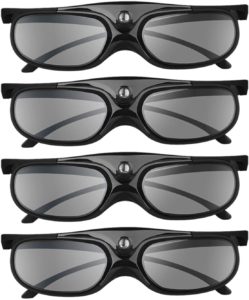

Sony no longer makes its own glasses, and instead recommends you buy the XpanD X105-RF-X1 glasses for use with this projector. The VW790ES supports active-shutter 3D, but if you want to take advantage of this feature you'll need to buy the necessary RF-capable glasses separately.
#BEST 3D GLASSES AVS TV#
However, don't use the Smooth mode with films or TV dramas because the frame interpolation will introduce the soap opera effect (SOE), which makes film look like cheap video. For sports broadcasts, you could try the low or high Smooth mode, which increases the motion resolution to around 600 lines and applies frame interpolation for smoother movement. The Motionflow controls include True Cinema, which results in excellent 24p playback, with 300 lines of motion resolution and no signs of judder. There are Reality Creation and Motionflow features, along with support for 3D, but the glasses are extra

Sony claims this works without adding digital noise, but if turned up too high it adds ringing and aliasing, masking genuine image detail, particularly in 4K content. Other features include Reality Creation, which uses sophisticated algorithms and databases to analyse images, and apply adaptive sharpening and edge enhancement to improve the perceived crispness of the picture. This was very frustrating, and a far cry from the lens memories on the JVC 4K projectors, which work perfectly every time. The lens memory was something of a disappointment, and never correctly returned to one of the saved aspect ratios.

There's also masking controls, so you can reframe content to its original wider aspect ratio, if presented opened up on a disc. This allows the projector to change from 1.78:1 material to other aspect ratios such as 1.85:1, 2.00:1, 2.20:1, 2.35:1, 2.39:1 and 2.40:1, gradually filling up the scope ratio screen as the aspect ratio widens. The VW790 includes fully motorised lens shift, focus and zoom controls, and also has a lens memory feature for use with scope ratio screens. The lens memory feature is annoyingly inaccurate, never correctly returning to a saved aspect ratio This performance is helped by Sony's Digital Focus Optimiser, which uses optical analysis to apply an algorithm that compensates for any lack of focus in the lens, producing sharper and more detailed images. In terms of white field uniformity, this was also excellent with no colour shift or dark edges visible. Test patterns look sharp and uniform, without any soft edges or chromatic aberrations. The lens appears to be high quality, with precise and detailed images. There is a zoom function that scales up to the native resolution of the panel, but this introduces artefacts, and it makes more sense to zoom up the image to fit the screen using the lens controls. Since the VW790ES uses a 4096 x 2160 panel, 4K Ultra HD resolution material (3840 x 2160) is shown with a slight black border at the sides of the image. As the projector uses three SXRD panels, these need to be aligned properly, and on the review sample this was excellent, with no obvious misalignment. Other benefits include fast on and off (20 seconds to turn on and near instant off), along with higher quality colours, better black levels and improved shadow detail. A laser light source has a number of advantages over a bulb, other than long life, such as significantly less dimming or drifting, which results in greater consistency over its life. Instead of a traditional UHP lamp, it uses a Z-Phosphor laser light source which Sony claims will last 20,000 hours and deliver up to 2,000 Lumens. The Sony VPL-VW790ES is a native 4K projector with a chipset that uses 4096 x 2160 pixels and SXRD (Silicon X-tal Reflective Display) technology. So let's put the Sony VPL-VW790ES through its paces, and see if it's worth the upgrade. Unusually, the VW790 is £3,000 cheaper than its predecessor, and costs £11,999 as at the time of writing (December 2020). This is designed to improve the perceived HDR image by using scene-by-scene processing, although it should be stressed that it doesn't use dynamic tone mapping. The projector also adds a new feature – Dynamic HDR Enhancer. The VW790ES adds the new 'X1 for Projector' picture processor, which ports over technology used in Sony's high-end BRAVIA TVs. This new projector uses an identical 4096 x 2160 chipset and Z-Phosphor laser light source as the earlier model with a claimed 2,000 lumens, along with all the same features such as motorised lens controls, lens memory, dual contrast control (dimmable laser light and dynamic iris), and digital focus optimiser for improved sharpness across the entire image. The Sony VPL-VW790ES is the latest 4K HDR SXRD projector from the company, and replaces the previous VPL-VW760ES.


 0 kommentar(er)
0 kommentar(er)
